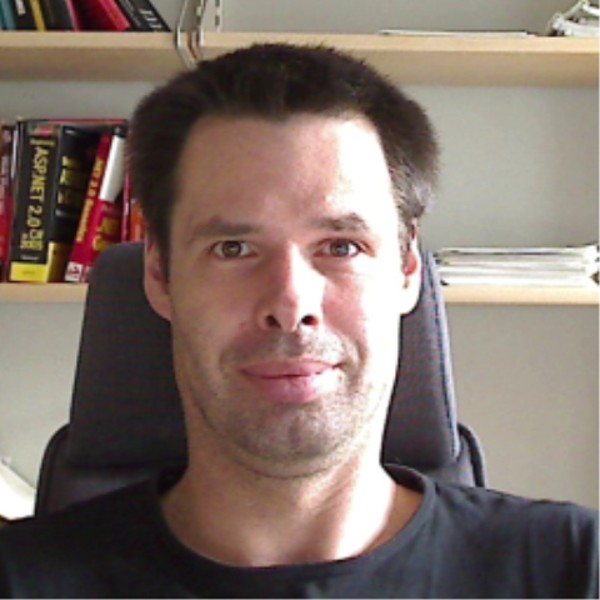Zoran Konkoli
What do you do? That is the standard question we get during the conference dinner. I am sure that most of my colleagues have a prepared answer that they can recite without even thinking. I’ve always had a problem explaining to people what I do while standing on one foot, especially if I wanted to avoid sounding too arrogant or raising an eyebrow or two as people listen: My background is truly interdisciplinary which is strongly reflected in my current research activities.
Background:
I started as undergraduate in Physics at Zagreb University (1986-1991), obtained a doctoral degree in Theoretical Chemistry at Gothenburg University (1991-1996). After that I wanted to learn the statistical physics toolbox and wanted to move into statistical physics. This happened through the series of three post-docs: 1996-2002, studied diffusion-controlled reactions (with Henrik Johannesson, Chalmers, Institute of Theoretical Physics), moved to the Nordic Institute of Theoretical Physics (NORDITA, now moved from Copenhagen to Stockholm) where I studied protein folding with John Hertz. There I learned a great deal of spin-glass physics. In that period I continued investigating diffusion-controlled reactions. My last post-doc was with Peter Appel at the Applied Physics Department at Chalmers, where I looked into polymer-translocation problem, a remarkably challenging multi-scale modelling problem. There I stayed as assistant professor in Biological Physics (2002-2006) and this is where my truly independent scientific life started.
In 2007 I obtained a permanent position of Associate Professor at the Department of Microtechnology and Nanoscience – MC2. By that time I got my employment at MC2 it was clear to me that my research interest lie at the interface between condensed-matter theory, statistical physics, theoretical cell biology, and computer science. I decided to develop in that area being fully aware of the fact that it was the time to focus which, alas, I did not do since there are so many interesting things to look at.
My research interests are as follows:
- non-equilibrium statistical physics (diffusion-controlled reactions, polymer dynamics in “exotic” geometries; in principle anything to do with fluctuation and noise)
- theoretical cell biology (effects of noise on gene expression networks, complex formation dynamics, and HIV latency)
- (theoretical) computer science (unconventional computation: neuromorphic computing, reservoir computing, computing with memristor networks, advanced sensing systems; formal models of unconventional computation; the implementation problem – “can a rock compute?”)
Reserach hobbies:
- mathematics in general
- formal logic
- measure theory
- approximation theorems
Impact of my research results:
This is a hard one for every theoretician. I am proud of saying that I have a strong network of people I interact with. These people (1) inspire me, (2) teach me things I do not know about, (3) tell me when I am wrong, and most importantly (4) implement some of my theoretical ideas.

Showing 46 publications
Ecosystem-based reservoir computing. Hypothesis paper
Undervisning anpassad till examinationsutfall
On Improving the Computing Capacity of Dynamical Systems
On Sensing Principles Using Temporally Extended Bar Codes
On a generic theory of the organic electrochemical transistor dynamics
On Mathematics of Universal Computation with Generic Dynamical Systems
Memristor Models for Early Detection of Sepsis in ICU patients
Reservoir computing with computational matter
Molecules, semiconductors, light and information: Towards future sensing and computing paradigms
East-West paths to unconventional computing
A Perspective on Putnam’s Realizability Theorem in the Context of Unconventional Computation
On Information Processing with Networks of Nano-Scale Switching Elements
Forces on an attractive surface generated from a thermoresponsive polymer gel
A generic simulator for large networks of memristive elements
Aspects of computing with locally connected networks
Safe uses of Hill's model: an exact comparison with the Adair model
Multiparticle reaction noise characteristics
Spontaneous noise reduction in a strongly cooperative reaction model
Controlling Chemistry in Dynamic Nanoscale Systems
A danger of low copy numbers for inferring incorrect cooperativity degree
Diffusion controlled reactions, fluctuation dominated kinetics, and living cell biochemistry
Multiparticle diffusion limited kA->0 reaction in small volumes
Controlling Chemistry by Geometry in Nanoscale Systems
Diffusion Controlled Reactions, Fluctuation Dominated Kinetics, and Living Cell Biochemistry
Transport Phenomena and Chemical Reactions in Nanoscale Surfactant Networks
Tunable filtering of chemical signals in a simple nanoscale reaction-diffusion network
Controlling enzymatic reactions by geometry in a biomimetic nanoscale network
Interplay between chemical reactions and trasport in structured spaces
Diffusive transport in networks built of containers and tubes
Controlled initiation of enzymatic reactions in micrometer-sized biomimetic compartments
Controlled initiation of enzymatic reactions in micrometer-sized biomimetic compartments
Biomimetic nanoscale reactors and networks
Download publication list
You can download this list to your computer.
Filter and download publication list
As logged in user (Chalmers employee) you find more export functions in MyResearch.
You may also import these directly to Zotero or Mendeley by using a browser plugin. These are found herer:
Zotero Connector
Mendeley Web Importer
The service SwePub offers export of contents from Research in other formats, such as Harvard and Oxford in .RIS, BibTex and RefWorks format.
Showing 2 research projects
Reservoir Computing with Real-time Data for future IT (RECORD-IT)
SYnaptic MOlecular NEtworks for Bio-inspired Information Processing (SYMONE)